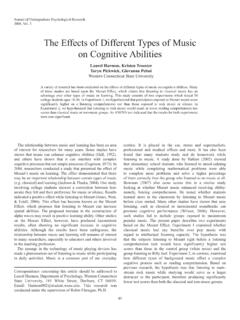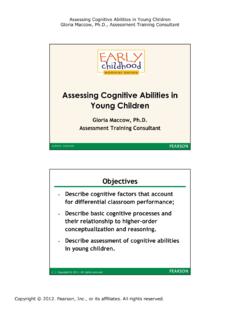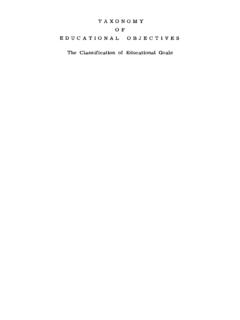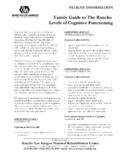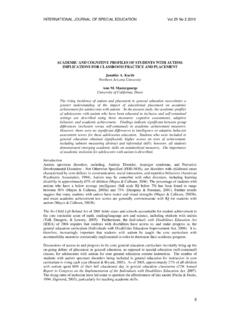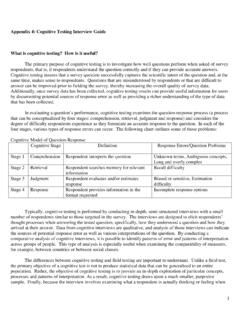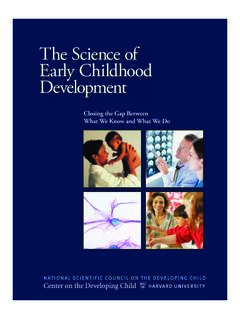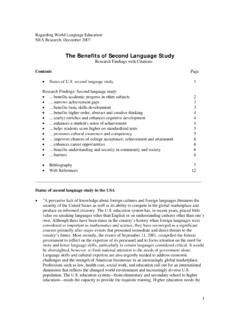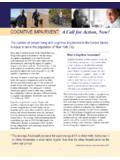Transcription of Cognitive Strategies Use in Reading Comprehension and its ...
1 Cognitive Strategies Use in Reading Comprehension and its Contributions to Students' Achievement Imam Suyitno, Universitas Negeri Malang, Indonesia IAFOR Journal of EducationVolume 5 Issue 3 Winter 2017107 Abstract The study outlined in this article describes the use of Cognitive Strategies designed to aid the Comprehension of Indonesian texts. It also examines the contributions of such Strategies to students' Comprehension scores. The participants were 97 students who had completed and passed the Reading course. In collecting the research data, the researcher used a Reading Comprehension test instrument in the form of a cloze test, as well as a Likert scale questionnaire.
2 The cloze test was used to measure the students ability to understand the texts, while the questionnaire was used to obtain information about Cognitive Strategies used by students in Comprehension of the texts. Data collection of the Comprehension test results and understanding strategy data are performed sequentially over the same day. Research data are described and analyzed by product moment correlation technique. The research found that students' scores in cloze tests ranged from A to D. This score indicates that students have varying abilities in Reading Comprehension . The research findings also showed that students used various Cognitive Strategies in understanding text Reading .
3 The results of the correlation analysis showed that the use of Cognitive strategy has a positive or negative contribution to the results of Reading Comprehension depending on the accuracy of the selection strategy in accordance with the text he read. Keywords: Cognitive strategy; text Comprehension ; contribution; Reading score. IAFOR Journal of EducationVolume 5 Issue 3 Winter 2017108 Introduction Reading ability is a main vehicle for the development of learning experiences and improved learning success. Hazzard (2016) states that Reading makes a significant contribution to the success of the learner in completing their studies.
4 Through the Reading process, the learner can obtain the information required to fulfill the needs of their study assignments. In fact, the ability to read is crucial, thus the process of learning to read well plays an important role in achieving success in both study and in life. People who read a lot can gain considerable useful information and knowledge in their lives. Anderson, Hiebert, Scott, and Wilkinson (1985) explain that Reading is an activity needed by a person to gain useful knowledge in their life, both in school and outside school. In reality, we can see that people who read more are able to solve problems more easily than those who do not. The differences are seen more clearly in the learning activities, namely, those students who read more have different academic behaviors than those of students who rarely read.
5 From these conditions, it can be said that interest in Reading significantly influences the score of students' Reading ability (Gambrell, 2011). Reading Comprehension is the mental process the reader goes through in an effort to understand the content of a Reading text. OECD, as cited by Kendeou (2014), states that Reading Comprehension is a process to understand, use, reflect on, and engage written texts, in order to achieve one's goals, to develop one s knowledge and potential, and to participate in society . Otto (1979, p. 147) explains that in Comprehension of a Reading , the reader not only pronounces written symbols, but also seeks to understand and interpret the information contained in the text.
6 Tinker (1975, p. 7) reveals that the ability to read is basically the ability to understand the information conveyed by the author in the Reading text. further, Smith and Robinson (1980, p. 205) describe Reading as a process of interaction, involving a reader engaging with the information submitted by the author through the text. Through this process, the reader seeks to understand, evaluate, and utilize the information and ideas being presented. In Reading Comprehension , to understand the text, the reader needs to apply a Comprehension strategy appropriate to the text they read (Smith and Robinson, 1980, p. 205). These Strategies include selecting, predicting, confirming, and validating the results of the understanding.
7 The use of these Strategies has an effect on the reader s success in comprehending the content of the text (Cohen, 1986, p. 133). This means that the use of the right strategy can optimize the results of Comprehension while the use of inappropriate Strategies can be a barrier to the success of Comprehension . In the learning process of Reading , teachers should introduce and train students to utilize appropriate Strategies in the Comprehension of Reading texts. In traditional teaching methods of Reading , teachers generally only apply the principle of task, work, and evaluation. Through this principle, teacher-student interaction is achieved only by assigning tasks or questions to students; students working on and answering teacher questions; then teachers assessing student answers (Porath, 2014, p.)
8 627). Such learning interaction does not provide a meaningful experience for students because students do not play an active role in building their learning experience. In teaching Reading Comprehension , teachers need to direct student activities in order to get to know and use the correct Reading strategy. The results of Francois s research (2016) show that in the process of learning Reading , teachers can be models in Reading Comprehension IAFOR Journal of EducationVolume 5 Issue 3 Winter 2017109 Strategies . Teacher can give examples various Reading Comprehension Strategies , for instance, including predicting, activating prior knowledge, making connections, setting purpose for Reading , and making inferences.
9 Francois (2016) thus states that by doing so, internal Comprehension processes are made explicit and students gain metacognitive knowledge of how and how to implement particular Strategies to aid in their understanding of texts . In Reading Comprehension , readers use different Strategies . The difference in strategy is due to differences in attitudes and Cognitive styles that the reader has in responding to the information in the Reading text. This fact is in accordance with the findings of research conducted by Pfister (cited in Sadeghi, 2012), which shows that students who have an open nature and a free field learning style have a high score in understanding the Reading text.
10 Brown (2007) explains that learning Strategies have a close relationship with learning styles and self-factors or personalities of those learning. Therefore, Hazzard (2016) explains that if the learning strategy is not in accordance with the learning style, students cannot learn the language well. According to Brown (2007), language learning Strategies can be grouped into three kinds: Cognitive Strategies , metacognitive Strategies , and socio-affective Strategies . The three kinds of Strategies have variants in their use in language learning. This depends on the Cognitive style and the learner's understanding of the strategy he or she occupies. In line with the diversity of these Strategies , this article focuses its discussion on Cognitive Strategies in Reading Comprehension .










